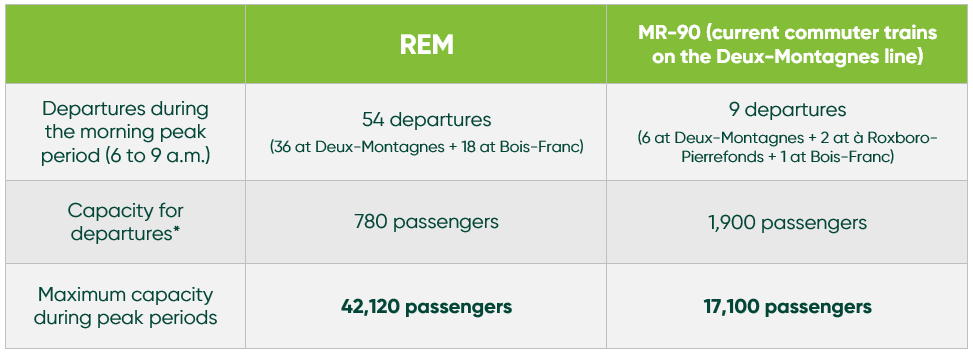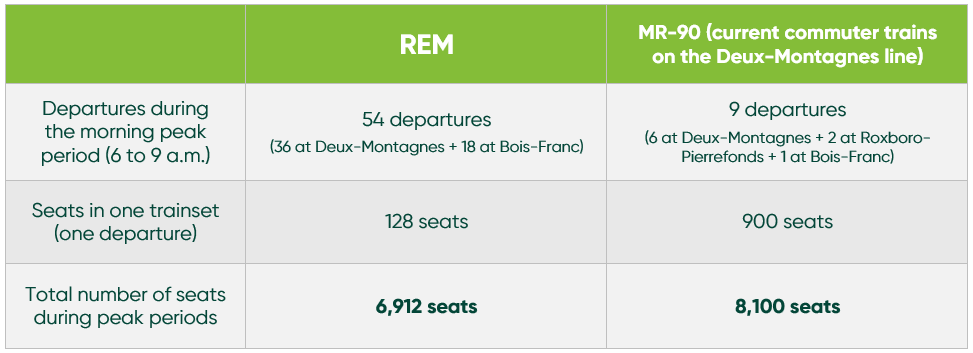
The REM, seating and capacity
How many seats will be available in REM cars? Will total capacity really be increased for current Deux-Montagnes line users? Many of you have been asking these questions, here are the calculations.
2.5 times more people will be able to board during rush hour
Although some people’s first instinct is to compare the MR-90 trains on the Deux-Montagnes line to the REM’s light-rail cars, such a comparison is wrong from the outset.
While REM cars are smaller than the MR-90, it is important to note that the REM’s frequency will be much higher than that of the current line (every 2 min 30 seconds between Central Station and Du Ruisseau, and every 5 minutes between Du Ruisseau and Deux-Montagnes). The high frequency means that many more seats will be available. The REM has a capacity of 42,120 passengers during the morning rush hour, from 6 to 9 a.m.

*The figure of 600 passengers is frequently mentioned for the REM cars. This figure reflects the theoretical capacity but, as in all networks, this does not represent the maximum capacity. The figure of 780 passengers allows a more accurate comparison with the maximum capacity of the Deux-Montagnes line.
A high-frequency system such as the REM offers distinctly more capacity than the current system (+150%). And if ridership is more than expected? The REM’s frequency can be increased, without having to reconstruct the existing infrastructure.
About seating
You have undoubtedly heard about the number of seats in REM cars. Yes, the number of seats is down overall with the REM, but not by much. The REM will continue to provide a large number of seats, with close to 7,000 seats available during the morning rush hour.

The new service is equivalent to a reduction of about 15% in the number of seats. However, this situation is compensated by high frequency, speed, quality of service and more connections with the Montréal metro.
For comparison: the new Azur cars on the STM network contain 30% fewer seats and they are considered to be more comfortable and more modern than the previous MR-73 cars (Azur: 28 seats vs MR- 73: 40 seats). This is because modern cars are designed to comfortably accommodate people standing during the trip, which is not the case for commuter trains.
What should we understand from these figures and the situation?
- REM cars are smaller than MR-90 cars, but run much more frequently, due to the high frequency of the light rail metro line.
- REM trains are not commuter trains, but more closely resemble a metro. Its cars are more akin to those found in Montréal’s metro. As the REM gets closer to the Gare Centrale, some people may have to stand, but the space is designed to accommodate this dynamic (poles, bars, larger spaces), which is not the case in the current commuter train.
- Commuters from Bois-Franc will have the possibility of boarding trainsets coming from the airport (one in four trains), which have a larger residual space. Since the airport’s peak hours are not the same as the regular peak hours, not many people will be on board when the trainsets reach Bois-Franc.
- Lastly, the REM’s high frequency will allow it to offer greater flexibility to users, some of whom may be tempted to make use of the regular service, i.e. before 6 a.m. or after 9 a.m.
Do you have questions about the Deux-Montagnes line and upcoming work? Consult our dedicated page and FAQ related to the subject.
Note : The article was updated in March 2019. The number of seats per REM car was increased from 120 to 128 in the final design version.